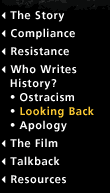|
The recovery of the story of organized resistance changes the way we look at camp history. The war hero, Ben Kuroki, was living in seclusion in Southern California when he agreed to be interviewed so he could tell his side of the story and soften some of the statements he made a half-century before. Wartime JACL leader Mike Masaoka issued a strong rebuttal to his critics in a 1982 speech to a JACL convention.
In 1990 the JACL commissioned an outside investigator to research the group's own wartime conduct. Upon seeing her report, JACL leadership disavowed it and for many years suppressed it, leading to a decade of rumor and suspicion until its recent publication on the Internet. Mr. Masaoka's wartime record came under fire again when an excerpt from his 1940 "JACL Creed" was inscribed on the National Japanese American Memorial to Patriotism During World War II, which was dedicated in Washington D.C. on November 9, 2000.
|
Documents, Video and Audio |
 Get RealPlayer Get RealPlayer |
 |
Research Report prepared for Presidential Select Committee on JACL
Resolution #7
submitted in 1990 by Deborah K. Lim
The complete and unexpurgated research paper popularly known as the "Lim Report," after its author, San Francisco attorney Deborah K. Lim.
|
 text
text |
|
|
|
 |
from "They Call Me Moses Masaoka,"
(1987)
MIKE MASAOKA on the draft resisters
|
 text
text |
|
|
|
 |
Statement of Mike Masaru
Masaoka (August 10, 1982)
MIKE MASAOKA in a rebuttal to critics at the 27th Biennial JACL National Convention in Los Angeles
|
 text
text |
|
|
|
 |
MIKE MASAOKA on his legacy
(1988)
In an exclusive interview with the filmmaker, Mike Masaoka reflects on his legacy.
|
 transcript
transcript |
|
 audio
audio |
|
 |
BEN KUROKI looks back
Video
BEN KUROKI: I was quoted as saying that those resisters were fascists and they're no good to the country, and certainly were tearing down everything that I was trying to do.
INTERVIEWER: Do you still believe that, today?
BEN KUROKI: Well, I think it was pretty strong stuff. I probably wouldn't say that today!
|
|
 video: 56k | DSL video: 56k | DSL |
|
|
 |
"Drawing the Line" (July 1995)
An artist's representation of the past by poet LAWSON FUSAO INADA
|
 text
text |
|
|
|
 |
THE MEMORIAL CONTROVERSY
"Japanese Americans Disunited: How a memorial to unify the Japanese American community became a symbol of disunity," by Francis Y. Sogi and Yeiichi (Kelly) Kuwayama.
|
 link to site with text
link to site with text |
|
|
|
 |
THE MEMORIAL CONTROVERSY
A response to critics is posted on the Web site of the National Japanese American Memorial Foundation, which raised funds for the memorial.
|
 link to site with text
link to site with text |
|
|
|
 |
|



